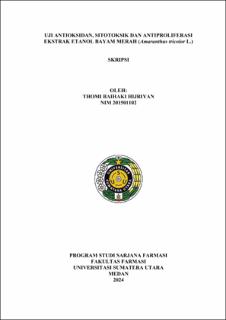Uji Antioksidan, Sitotoksik dan Antiproliferasi Ekstrak Etanol Bayam Merah (Amaranthus tricolor L.)
Antioxidant, Cytotoxicity and Antiproliferation Tests of Ethanol Extract of Red Spinach (Amaranthus tricolor L.)

Date
2024Author
Hijriyan, Thomi Baihaki
Advisor(s)
Wahyuni, Henny Sri
Hasibuan, Poppy Anjelisa Zaitun
Metadata
Show full item recordAbstract
Background: Breast cancer was the biggest cancer case in Indonesia in 2020.
Existing treatments caused side effects, so it was necessary to use alternative
treatments based on natural ingredients such as Amaranthus tricolor L., known to
have various active compounds that had potential through previous In Silico studies
as antioxidants and anticancer agents.
Objective: To determine antioxidant, cytotoxic and antiproliferation activity of
herbs red spinach ethanolic extract against cancer cells MCF-7 and 4T1.
Methods: This study began with the preparation of simplisia, extraction using
maceration method, characterization of simplisia and extract, phytochemical
screening tests, then antioxidant, cytotoxic and antiproliferation testing of extract
ethanolic of red spinach (Amaranthus tricolor L.) was carried out using DPPH for
antioxidant activity and the MTT assay method for cytotoxicity dan
antiproliferation.
Results: The results showed that the characterization of the extracts and simplisia
of red spinach herb had passed standardization. The chemical compounds contained
in the extracts and simplisia were alkaloids, flavonoids, glycosides, steroids,
saponins, and tannins. The ethanol extract of red spinach herb showed strong
antioxidant activity with an IC50 value of 77,5787 ± 0,08 μg/ml. The anticancer
activity of the ethanol extract against MCF-7 cells had an IC50 value of 610,09 ±
1,23 μg/ml, which was classified as moderately cytotoxic, while against 4T1 cells
was classified as low cytotoxic with an IC50 value of 2971,13 ± 0,77 μg/ml. The
antiproliferative activity of the ethanolic extract of red spinach herb against MCF-
7 cells was dose dependent and time dependent, while against 4T1 cells it was time
dependent.
Conclusion: This research described that active compound of red spinach
(Amaranthus tricolor L.) had strong potential as antioxidant agent but low potential
as anticancer agent. that active compounds of red spinach (Amaranthus tricolor L.)
Collections
- Undergraduate Theses [1719]
